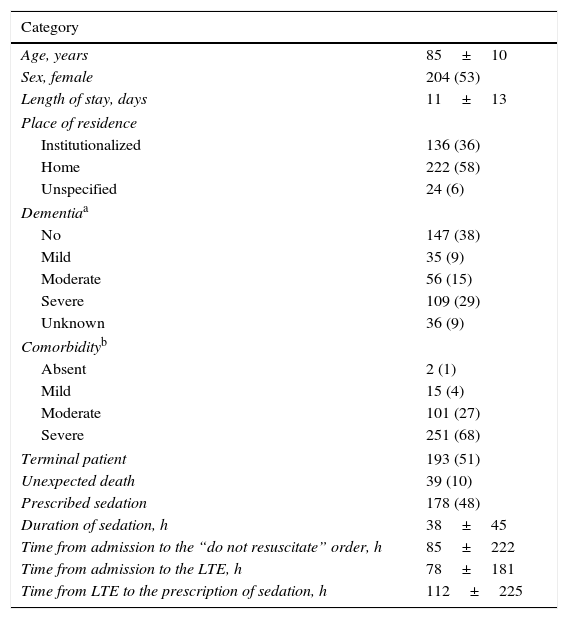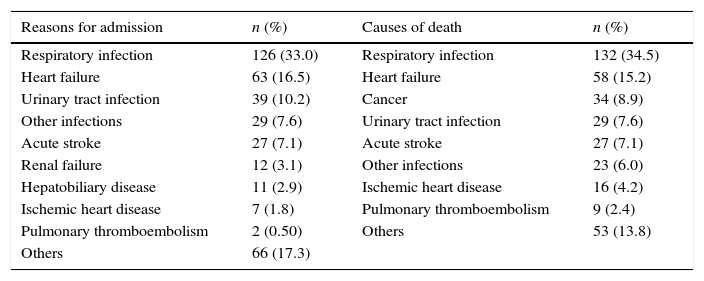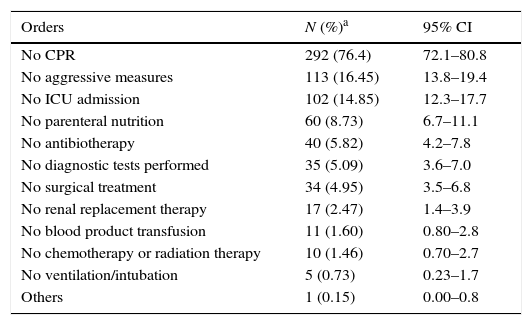There is little information on the limitation of therapeutic effort (LTE) in patients admitted to hospital internal medicine units.
ObjectivesTo describe the indicated LTE regimens in the departments of internal medicine and the characteristics of the patients who undergo them.
Patients and methodsAn observational, descriptive retrospective study was conducted on 4 hospitals of the Community of Madrid. The study collected demographic and comorbidity data and the LTE orders prescribed for all patients who died during a period of 6 months.
ResultsThe study included 382 patients with a mean age of 85±10 years; 204 were women (53.4%) and 222 (58.1%) came from their homes. Some 51.1% of the patients were terminal, 43.2% had moderate to severe dementia, and 95.5% presented at least moderate comorbidity. Some type of LTE was performed in 318 patients (83.7%); the most common orders were “No cardiopulmonary resuscitation” (292 patients, 76.4%; 95% CI 72.1–80.8), “Do not use aggressive measures” (113 patients, 16.4%; 95% CI 13.7–19.4) and “Do not transfer to an intensive care unit” (102 cases, 14.8%; 95% CI 12.3–17.7). Some type of LTE was performed in 318 patients (83.7%); the most common orders were “No cardiopulmonary resuscitation” (292 patients, 76.4%; 95% CI 72.1–80.8), “Do not use aggressive measures” (113 patients, 16.4%; 95% CI 13.7–19.4) and “Do not transfer to an intensive care unit” (102 cases, 14.8%; 95% CI 12.3–17.7).
ConclusionsLTE is common among patients who die in Internal Medicine. The most widely used regimens were “No CPR” and the unspecific statement “Do not use aggressive measures”. The patients were elderly and had significant comorbidity, terminal illness and advanced dementia.
Existe escasa información sobre la limitación del esfuerzo terapéutico (LET) en pacientes ingresados en unidades de hospitalización de medicina interna.
ObjetivosDescribir las pautas de LET indicadas en los servicios de medicina interna y las características de los pacientes que las reciben.
Pacientes y métodosEstudio observacional descriptivo y retrospectivo de 4 hospitales de la Comunidad de Madrid. Se recogieron datos demográficos, de comorbilidad y las órdenes de LET pautadas en todos los pacientes fallecidos en un periodo de 6 meses.
ResultadosSe incluyeron 382 pacientes cuya edad media fue de 85±10 años; 204 eran mujeres (53,4%) y 222 (58,1%) procedían de su domicilio. El 51,1% eran enfermos terminales, el 43,2% tenían demencia moderada/grave y el 95,5% presentaban comorbilidad al menos moderada. En 318 pacientes (83,7%) se realizó algún tipo de LET, siendo las más frecuentes las órdenes de «no reanimación cardiopulmonar» (292 enfermos, 76,4%; IC 95%: 72,1-80,8), «no usar medidas agresivas» (113 pacientes, 16,4%; IC 95%: 13,7-19,4) y «no ingresar en unidad de cuidados intensivos» (102 casos, 14,8%; IC 95%: 12,3-17,7).
ConclusionesLa LET es muy frecuente en los pacientes que fallecen en medicina interna. Las pautas más utilizadas son «no reanimación cardiopulmonar» y la expresión poco concreta de «no usar medidas agresivas». Los pacientes son de edad avanzada, con importante comorbilidad, enfermedad terminal y demencia avanzada.
Article
Diríjase desde aquí a la web de la >>>FESEMI<<< e inicie sesión mediante el formulario que se encuentra en la barra superior, pulsando sobre el candado.

Una vez autentificado, en la misma web de FESEMI, en el menú superior, elija la opción deseada.

>>>FESEMI<<<










